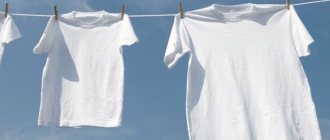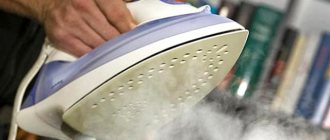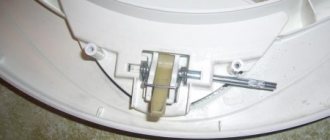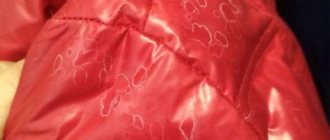Why does a thing lose its shape?
The main reasons for things to stretch after washing include improper washing and subsequent drying. Additional reasons not related to the washing machine are wearing the item for too long and bad habits of the person himself. Many people like to stretch the sleeves, pull the bottom tightly over the hips, and roll up the neck - this is done primarily to feel more comfortable and warm. But when performing such manipulations with a thing, it is important to remember that it will not pass without a trace - stretching will appear on certain parts of the product.
The speed at which a thing stretches and loses its shape also depends on the density of the loops. For example, if it was created by machine knitting, it is characterized by high density and resistance to stretching. If we talk about warm hand-knitted sweaters, then we should note the weak density of the loops. Moreover, there is no way to avoid such density. Each hand-knitted product loses its shape much faster than other things.
Sellers of knitted items advise that before washing, drying and wearing the product, do not neglect the information from the manufacturers, which is indicated on the label or packaging. You can also find such information on the official website. How to reduce a stretched sweater after washing? To do this, there are universal and effective ways to restore things.
Causes of deformation
Having discovered that the product has lost its previous shape, you first need to understand the causes of the deformation in order to know what to deal with to prevent it:
- Perhaps the most important of them is the composition of matter. All sweaters and voluminous cardigans are made of elastic materials, which tend to stretch. They can be reduced in ways that we will outline below.
- If you wear something every day, then frequent wear can also cause it to become deformed. Basically, the sleeves are stretched and the length of the product increases.
Important! This can also be caused by improper cleaning products, washing, ironing, and drying regimes.
When something like this happens to your favorite item, the desire to wear it disappears. It may seem to you that nothing can be done and all that remains is to throw it away and buy a new sweater. However, do not rush to make hasty decisions, because it can be pulled back.
Is it possible to return to the previous form?
Unfortunately, not all mechanically damaged tissue can be repaired. There are certain materials that cannot be restored at all or only in certain cases:
- acrylic, cotton material and things with a synthetic base do not restore their shape in any way;
- You can try to restore cashmere, wool and mixed fibers with a large amount of wool.
Turning
Facing is a piece of fabric, 4-5 cm wide, completely repeating the shape of the collar or collar and armhole, if a sleeveless model is sewn. This design allows you to close the cut in an invisible way, leaving an even, smooth edge. This is how the neckline without a collar is treated on factory items (except T-shirts).
It is desirable that the facing does not have any seams, except for the side and shoulder ones. To prevent the part from turning on its face, to keep its shape and to prevent the neckline from stretching, the facing is glued with dublerin or non-woven fabric.
The material of the part is usually the same as the main fabric. And it is sewn on according to the lining principle. When finished, the front side of the facing is adjacent to the body, the back side is adjacent to the back of the garment.
Grinding technology
The technology of stitching the facing is not very difficult:
- Place the main piece and facing with right sides together.
- sweep or secure with pins.
- Sew along the edge, retreating 2-5 mm.
- Turn it inside out (turn the facing to the wrong side of the main product), straighten and iron the seam.
- If the fabric density is high or the facing is too narrow, sew a stitch on the outside to secure it. In the usual case, it is enough to secure it with a couple of stitches on the side seams.
Restoring the shape of a thing
If a wool sweater stretches after washing, what should you do? You can restore the shape of a thing and its size using several methods at once.
If, after washing, a machine-knitted sweater has lost its original structure, then to restore it, you just need to put the product in the washing machine again, following the following rules:
- before throwing the item into the drum, you need to place it in a special bag;
- pour wool detergent into the compartment with the powder;
- activate quick wash mode;
- set the minimum temperature - only 30 degrees is enough;
- Before starting, be sure to turn off the spin mode - use the simple drain function;
- disable automatic drying of items;
- At the end of washing, the sweater is removed from the bag and gently wrung out by hand.
Preparatory process
What to do if the sole of your sneakers squeaks
A laundromat worker once shared a great hack for breathing new life into an old, worn-out T-shirt. According to her, to return this thing to its previous form, we need very little:
- a deep bowl of water with ice cubes floating in it;
- iron;
- table or any other flat surface.
All you need to do to tidy up your clothes is to gather the neck of the T-shirt into pleats so that it resembles an accordion. You will then need to plunge the collar into a bowl of ice water to strengthen the cotton fibers of the garment, while continuing to hold the pleats of the neckline together.
Moreover, the amount of time during which you should wet the T-shirt is not limited, but it is best to take it out as soon as your fingers freeze.
“Olga” from the series of the same name: the tragic fate of actress Yana Troyanova
Paralympian Talay without arms and legs: “the harder the fight, the greater the victory”
25 children of a childless man: an extraordinary reunion
Improved shape after repeated washing
My sweater has stretched out after washing - what should I do? When reconstructing a product, you need to perform the following steps:
- The sweater is carefully laid out on a towel or piece of fabric.
- Next, the owner gives the item the look that he considers ideal - the fabric in the sleeve area is pulled up, the waist is tightened and the neckline is neatly folded. To do this, you need to place your palms on the things and carefully, gradually grabbing the material, move them towards each other, avoiding the formation of folds. Smoothing the item begins with the seam, then gradually moves to the neckline and sleeves, then touches the remaining areas of the fabric.
- You can see the result immediately after the item is completely dry. The sweater will not lose the shape that the owner tried to give it at the time of reconstruction. It is important not to miss anything when recreating the volume of a thing anew.
Some sweater owners try to reduce it by several sizes by washing it. To do this, experts advise simply washing things in a machine at high temperature.
When drying, it is important to pay special attention to the condition of the towel mat. Immediately after it gets wet, it is important to remove it and place a new one under the item. When re-folding, the sweater must be re-shaped into the desired shape. If you do not change wet towels, the sweater may develop an unpleasant odor due to dampness.
Rework options
There are several different options for making your blouse smaller.
The specific choice depends on the detail that turned out to be large. To correct the cut you can:
- take the item to a professional tailor (atelier, private seamstress);
- start working on your own.
Everything is simple and clear if a specialist takes care of the clothes. You will have to come to the fitting 2 times and pay for the work.
But you can do without this if you get down to business yourself. First you need to determine what exactly needs to be done to solve the problem.
To reduce the size of a blouse, use the following options.
- Deepen the front and back darts (on the chest, on the waist).
- The side seams are sutured.
- Reduce in the side seams, in the seam of the back flange.
- The shoulder seams are sutured.
- Reduce according to the sleeve if it is too big.
- They tighten and drape excess material.
- They rearrange and re-stitch buttons.
- Wash at a certain temperature, taking into account the quality of the fabric.
- Dried using a special method.
Improving your shape with your own hands
What to do if the sweater has stretched after washing? This problem can be solved by another method - to act manually. To do this you need to do the following:
- The bath is filled with a small amount of warm water.
- The stretched item is carefully laid out on the surface of the water. In this case, you need to wait a little so that the sweater has time to soak in the liquid.
- After getting wet, the water goes down.
- The thing is doing push-ups.
- The sweater is wrapped in a terry towel and wrung out again. All actions must be careful; twisting is prohibited.
- The wet item is laid out on a towel in the same way as in the first case. The main thing is to give the sweater the most correct shape possible instead of being stretched out.
- If all steps were performed correctly, then when it dries, the sweater will restore its shape and previous size.
Some dry things differently - directly on themselves. Of course, you can restore an item by wearing it on your body, but the owner is unlikely to feel good. It is best to restore an item using this method if there is a mannequin nearby with approximately the same parameters, which will help reproduce the shape of the figure and return it to its previous shape.
It is important to remember that when using this method, the item can continue to dry throughout the day, and sometimes longer - this directly depends on the density of the material. It is forbidden to try to speed up the drying process by moving the product onto a radiator, heated towel rail or heating device - this will ruin the thing (you will have to throw it away).
Wool clothing
Factory-produced wool items are denser and less likely to deform. When knitting at home, the loops are weaker, which is the main reason for sweaters, jumpers, cardigans, etc. to stretch.
There are several ways to restore products.
Repeated washing in accordance with the rules
In order for a wool sweater to recover after repeated washing, it is recommended:
- Purchase a special mesh bag in advance.
- Buy a liquid product for wool items, since you cannot use regular powder in this case.
- Wash only on the “Wool” cycle. If it is not there, then choose a temperature no higher than 30 degrees. No need to dry or squeeze.
- After finishing washing, wring out the product a little by hand.
- Place a terry towel on the floor, and gently and evenly wash the item on it, giving it the desired shape. Periodically replace a wet towel with a new one.
- Leave the product until completely dry.
Woolen items should not be ironed.
If you want to reduce the size of a sweater or cardigan, then you should follow the same steps, only the water temperature should be 40-50 degrees.
Manual method
If you don’t have a washing machine, you can achieve the desired effect without it:
- Fill the bathtub with warm (not hot) water about halfway.
- Place the stretched item in it so that it is saturated with water.
- After some time (20–40 minutes), squeeze.
- Lay the item on a sheet or towel, giving it the desired shape.
- Leave until dry.
Using this method, woolen items take a day or more to dry. At the same time, hanging them on the radiator or ironing them is strictly prohibited.
If you need to dry something quickly, you can use a hairdryer in cold air mode. Hot deforms wool fibers.
Recent entries The best models of sneakers for all occasions: a review of trending brands, their new products and proven flagships Summer trousers 2022: choosing trending colors, styles and fabrics Fashionable clothing styles: trends 2021-2022 for women, men and children of any age and body type
Restoring individual parts of a sweater
If not the entire item is stretched, but only the sleeves or neckline, you can restore them quickly enough. To do this you need:
- Fill a spray bottle for indoor plants with water.
- Place the product on a towel or sheet.
- Moisten the deformed parts with a spray bottle, carefully lay them out and let them dry completely.
If there is no result, it is recommended to wash the entire item.
Partial restoration
If after washing, drying or wearing only a certain area of the sweater has lost its shape, then you can use the following method:
- wet the damaged fabric of the item with a water spray;
- carefully lay the sweater on a towel or terry cloth;
- give the lost area its previous shape;
- After a few hours, the sweater will acquire a uniform structure and a suitable size.
A hairdryer will help speed up the drying process. But only cold air flow is allowed for this. Hot jets can only damage the fabric and make it unusable.
How to reduce a jacket in a certain area
Sometimes a jacket can only stretch in certain areas. The most problematic areas are the cuffs, sleeves and neckline. Often a jacket or sweater stretches from the bottom. In this case, there is no need to soak or wash the product. To reduce sleeves, neckline, cuffs or other parts of a sweater, pour hot water into a spray bottle or spray bottle.
Spray water generously on the desired area of clothing and shape it into the desired shape, lay the item to dry on a horizontal surface. Leave to dry. You can dry things using a hairdryer with cold air. This will help dry the fabric faster. What to do to quickly dry clothes, read the link.
Additional Methods
My sweater has stretched out after washing - what should I do? If the previous methods did not correct the situation, then the following measures are used:
- If the item has stretched slightly as a result of long wear, it will be easy to return it to its previous shape by washing it in cold water and drying it in a horizontal position.
- The sweater is soaked in hot water for 10–15 minutes, and a special detergent for washing woolen items is added. After soaking, hand wash. Next, leave the item in cold water for 20 minutes, having previously wrung out the fabric without unscrewing it. The sweater is dried on a horizontal rack. After all the excess water has drained away, the item is carefully laid out on a dry towel, sheet or any other fabric. Afterwards it is given the desired shape.
If your denim jacket is stretched
- To shrink a denim jacket in a certain area, for example, in the waist, sleeves or shoulders, mix warm water and conditioner in a ratio of 3 to 1. Spray the solution on the desired area and dry the product in an electric dryer, washing machine or radiator. Repeat the procedure until you get the required size;
- Wash denim in the washing machine at the highest temperature setting on the intensive or wrinkle-resistant cycle. Then dry the jacket and iron the dried material with a hot iron;
- An old and worn denim jacket, as well as a light-colored denim jacket, can be boiled. To do this, place the product in boiling water and cook over medium heat for 30 minutes. It is important that the clothing is completely submerged in water. This method will dull the color, resulting in a “washed” denim jacket with a smaller size;
- To prevent denim from shrinking, wash the material by hand at temperatures up to 40 degrees. Do not dry items in the fresh air or throw them over a rope, otherwise streaks and marks will remain. You can read more about caring for denim in the article on how to reduce jeans size.
Self-stitching
Any item of clothing can be worn with pleasure only if it fits well. T-shirts are no exception to the rule. Therefore, if the purchased summer wardrobe item has too wide shoulders, inappropriate length or a narrow collar, you should try to alter the item yourself. If you have minimal sewing experience, there should not be any particular difficulties in deciding how to hem a T-shirt on a sewing machine.
A T-shirt that doesn't fit is not a problem
Important! The item to be altered must be clean and ironed
Neck
The sewn-on neckline on knitted T-shirts tends to stretch during wear. The neckline becomes too large and fits poorly. There are many ways to stitch the neckline of a T-shirt. The simplest of them involves doing the following:
Prepare pins, a hand knitting needle (with a blunt tip) or a sewing machine. Turn the product inside out. Turn the edge of the collar over to the wrong side and carefully pin it with pins. Sew the trim by hand or sew on a sewing machine
It is important that the stitching is elastic.. It is not difficult to bring a stretched neck of a T-shirt back to normal. There is another scheme, it involves tearing off the neck and re-sewing it
But it’s worth giving a step-by-step master class of this process:
It is not difficult to bring a stretched neck of a T-shirt back to normal. There is another scheme, it involves tearing off the neck and re-sewing it. But it’s worth giving a step-by-step master class of this process:
- Peel off the collar trim from the T-shirt.
- Open any shoulder seam by about 2 cm.
- Iron all parts of the product.
- Cut the seam from the finishing strip.
- Unfold and iron the strip again, stretching it at the same time.
- Finish one of the long edges of the plank with an overlocker.
- Place the placket and T-shirt with right sides facing each other.
- Baste so that the neck line and the raw edge of the placket coincide.
- Cut off the excess part of the plank.
- Sew the bar.
- Turn the stitched strip to the wrong side and baste.
- Attach the placket and stitch side by side at a distance of 0.5 cm.
- Sew up and finish the ripped section of the shoulder seam.
You should use the method of tearing off the neck only if you have enough sewing experience. Home conditions do not always allow you to use this method, since not everyone has an overlocker.
On the sides
It often happens that you buy or receive as a gift a T-shirt that is larger than you need. Don't rush to turn it into a spacious home outfit. After all, sewing a T-shirt one size smaller on your own won’t be difficult at all.
It’s easy to sew the sides of a T-shirt
It’s ideal if you have a cover stitcher and an overlocker, but if you don’t have them, any modern machine that has an overlock stitch will do. Next, the algorithm of actions to reduce the product on the sides will be as follows:
- During the fitting process, mark the locations of future seams - each side, from below and to the armhole line.
- Without ripping the seams, cut off the overlock stitch both on the sides and in the armhole.
- Mark the line of the future seam with chalk (it is better to use a pattern).
- Fold the T-shirt in half lengthwise, align the cuts and pin everything together (the left and right sides should be identical).
- Mark the new armhole line with chalk.
- Do not remove the pins, but use them to pin together the back, front and armhole.
- Fold the product along the shoulder seams and pin together.
- Cut off all excess, leaving a seam allowance of 0.7 cm.
- Fold the sleeves together, making sure to pinch the bottom.
- Mark the highest point on the rim line with chalk.
- Mark the front part of the part, transfer similar marks to the second sleeve.
- Remove all pins.
- Align the sleeve caps with the armholes, and the highest point of the cap with the shoulder seams.
- Sew all seams. It is recommended to sew the sides and sleeves in one go.










